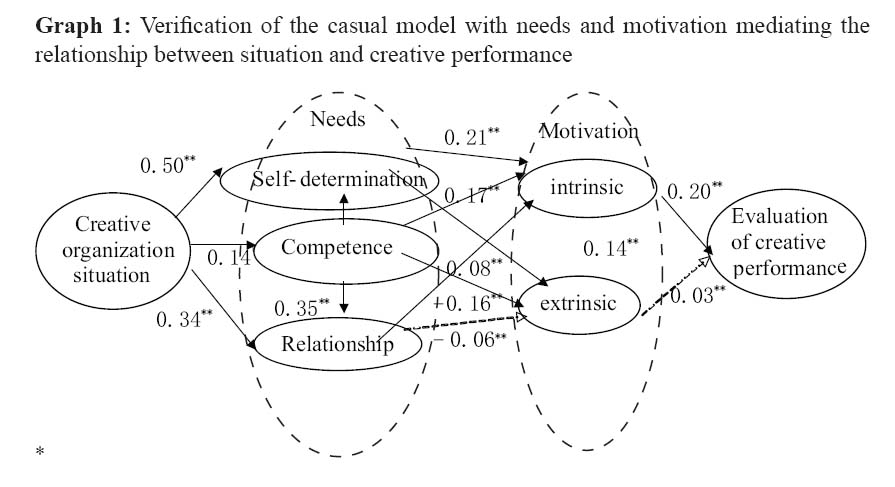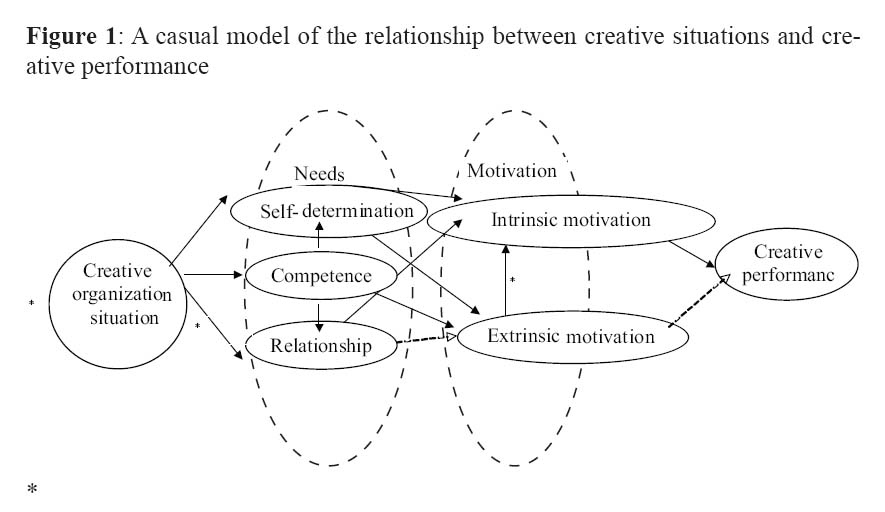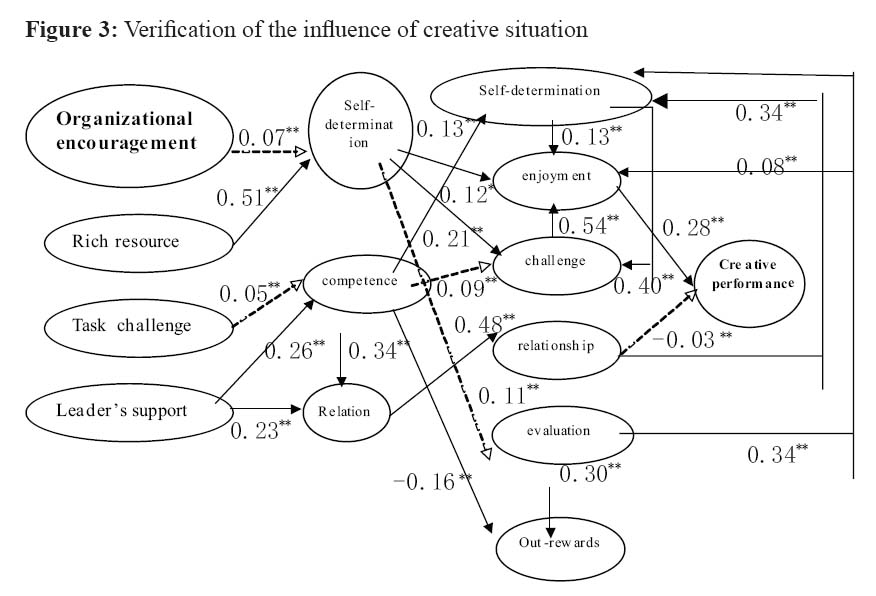A Study on the Motivational Mechanism of Creative Situations
Z. JianUniversity of Science & Technology Beijing, China
Y. Qian
University of Science & Technology Beijing, China
Z. Fei
University of Science & Technology Beijing, China
Using the organismic dialectical metatheory and the empirical research approach, this study systemically explores the relationship between creative situations and creative behavior. The study finds that the opinion proposed by organismic dialectical metatheory, that needs and motivation mediate the situation and the behavior, is true. Also, support from leaders and the richness of resources are primary components of creative situations. Furthermore, the satisfaction of self-determination and competence is at the core of creative activity; enjoyment is the direct cause for creative behavior, and pursuit of challenges is the most important indirect cause.
Introduction
1 A creative situation is defined as the perception of the circumstance that influences the organizational creativity (Amabile, 1997). Motivation is generally considered to be the individual inherent mental process led, stimulated, and kept by the goal or internal motive force (Pintrinch and Schunk, 1996), which is often differentiated in the creative research field by two types: intrinsic and extrinsic motivation (Amabile, 1999). In recent years, researchers have started to examine the effects of motivation on the relationship between the organizational environment and creative performance. But most of these studies are done within the frame of cognitive evaluation theory, of which there are already many criticisms. Many people think it is difficult to define the so-called environment of "information" and "control" (Eisenberger and Cameron, 1996). Thus, we need some new theories to explain the relationship between the organizational situation and creativity.
2 In recent years, with the development of studies on motivation, there appear to be many new ideas about intrinsic and extrinsic motivation. The most representative and influential one is the self-determination theory (Deci and Ryan, 2000). As the theory develops further, organismic dialectical metatheory tries to use the concept of psychological needs to integrate different opinions in the area (Deci and Ryan, 2000). This theory proposes that there are three kinds of psychological needs which are inherent, universal, and common in human beings: self determination, competence, and relationships. When the environment satisfies these three needs, it will support intrinsic motivation and promote the individual’s behavior. Valle-rand (1997) puts forward a casual model to explain the relationship: social factors- psychological mediators- different kinds of motivation- results.
3 Though organismic dialectical metatheory is meaningful to creative study, there is no experiment under its direction in the field of creative behaviors. There are three purposes for conducting this study. The first is to take the organismic dialectical metatheory as a framework and to establish a new model of motivational mediation between the organizational environment and creative performance. The second is to distinguish the types of needs and motivations in order to explore the path between creative situations and creative performance using Covariance Structure Analyses. The last is to examine the relationship among the mediators.
Methods
Samples
4 Samples are employees and their supervisors from Beijing and Jiangxi province, who are 689 in total. The number of male participants is 355, and the other 334 are females.
Hypothesis
5 Creative situations influence creative performance significantly through needs and motivation (Figure 1).
Figure 1: A casual model of the relationship between creative situations and creative performanceMeasures
The questionnaire of creative situation
6 The questionnaire was designed by Zhang Jian (2003), and is used to measure the situation that can influence creative performance in organizations. There are four factors on the scale and 40 items. The Cronbach’s alphas of the scale are 0.8589, 0.8135, 0.7930, 0.5440 respectively, suggesting good stability among the four factors.
The questionnaire of the satisfaction of psychological needs
7 The questionnaire is used to measure satisfaction of the three kinds of psychological needs, which is adopted from Nikos Ntoumanis (2001). The scale has three factors and 15 items. Its stability and validity have been verified.
The questionnaire of motivation in employees
8 The questionnaire was designed by Zhang Jian and Guo Dejun (2003), and effectively measures the motivation of employees according to five factors: self-determination, pursuit of challenge, good relationship, evaluation from others, and out-reward. A factor of enjoyment was added into the scale, because many studies point out that this is important for creative motivation. The questionnaire includes 6 factors and 36 items. The Cronbach’s alphas of the scale are 0.6356, 0.8275, 0.5860, 0.6624, 0.7327, and 0.5465.
The questionnaire about creative performance of employees
9 The scale is abstracted from Zhou (2001)’s study. The Cronbach’s alpha is 0.9319, suggesting good reliability.
Procedure
10 The employees filled out the scale, which consisted of a questionnaire on creative situations, a questionnaire on the satisfaction of psychological needs, and a questionnaire on motivation. Their supervisors filled out the scale about creative performance for everyone. All items are scored on a 5-point scale.
Results
11 Verification about the casual model with needs and motivation mediating the relationship between situation and creative performance
12 Covariance structure analyses were performed. As recommended by Byrne (Byrne 1998), several procedures for all covariance structure analyses, presented in the paper, were followed: LISREL 8.02 was used to conduct the analyses; the input data was a variance-covariance matrix; one item per concept was fixed at 1.0; a simple structure was maintained; the phi matrix was set as a free symmetric matrix; and the delta was a diagonal free matrix. The result is shown in Graph 1 and Table 1.
Graph 1: Verification of the casual model with needs and motivation mediating the relationship between situation and creative performance

Display large image of Figure 2
Table 1: Verification of the casual model with needs and motivation mediating the relationship between situation and creative performance

Display large image of Table 1
13 As shown in Table 1, it was found that the assumption model forecast employees’ creative performance significantly. The fit indices such as GFI, AGFI, NNFI and CFI were all more than 0.89, suggesting a good fit between the assumption and the data. Further analysis showed that the creative situation was significantly related to the three basic needs, which have the most influence on self-determination, and more on relationship, and the least influence on competence. It was also found that the satisfaction of the three psychological needs is significantly related to intrinsic motivation and that intrinsic motivation significantly correlates with creative performance. Such results prove that the theory of organismic dialectical metatheory is reasonable and correct in the creative research area. From the results a conclusion can be drawn that intrinsic motivation can predict creative performance significantly. Although extrinsic motivation does not have a significant effect on creative performance, it can promote intrinsic motivation positively.
The path exploring and verifying the factor of creative situations and creative behavior
14 The exploration function of the covariance structural analysis was adopted to confirm the essential feature of creative situations. The samples were randomly divided into two groups. The numbers are 467 and 464 respectively. A path exploratory study was performed on one sample, and it got the following structural model in terms of the theoretical feasibility and data result emendation, shown in Figure 2 and Table 2.
15 This model has a good fit index, shown in Table 2. The variance of the model account is 11%. While using the other samples to verify this model, it was discovered that the fit index decreases slightly, but in the accepted scope. It was proved that what is found from exploration analysis is reasonable to some extent. When all of the paths were carefully inspected, 5 paths that were not significant were found. Such results show that the suggested model is sometimes reasonable, but needs further exploring.
Figure 2: Exploration of the influence of creative situations

Display large image of Figure 3
Table 2: Models of exploration and verification
Figure 3: Verification of the influence of creative situationDiscussion
The model of needs and motivation as the mediator
16 Based on the organismic dialectical metatheory, a model for the influence of creative situations was constructed. The results show that it is accurate for the mediation of the needs and motivation between the creative situation and creative performance; and proves that organismic dialectical metatheory has great validity in the creative research field, which can produce meaningful guidance for creative encouragement in reality.
The relationship between creative situations and psychological needs
17 Combining the results of the exploration and verification research, the conclusion drawn is that, for Chinese enterprises, support from leaders and richness of resources are primary components in a creative situation. The factors that benefit creative behavior, such as richness of opportunity, abundant time, and adequate funds may make employees feel that in the company they are not restricted, producing the freedom of self-determination. Help and guidance from leaders may make the employees feel secured and satisfy the needs of the relationship. Such situations also satisfy the need of competence. But further research is still needed to confirm the contribution of organizational encouragement and task challenge, which may be the reason that innovation is very poor in the chosen enterprise. After all, the different factors in creative situations satisfy the different types of psychological needs. The transformation of creative situations should strengthen the features, which satisfies corresponding demands.
The relation between three kinds of psychological needs and work-motivation
18 In the path picture found from exploring research, the satisfaction of self-determination has a significantly positive correlation with enjoyment and the pursuit of challenges. The satisfaction of competence has a positive correlation with the motivation of self-determination and pursuit of challenges. The satisfaction of a relationship has a positive correlation with the motivation of pursuit of good relations. These results suggest that the satisfaction of 3 kinds of psychological needs really promote intrinsic motivation. But there is a gap between the results and the thought of organismic dialectical metatheory. The current studies found comparability with the satisfaction of physiological needs during the satisfaction of psychological needs. When some psychological needs are satisfied, the strength of this kind of need declines, and produces another type of intrinsic motivation.
19 To some extent, it can be verified that the satisfaction of psychological needs can weaken external motivation. We found that the satisfaction of competence has negative effects on the motivation of out-rewards. Even if the satisfaction of psychological needs produces positive effects on external motivation, extrinsic motivation has a positive effect on intrinsic motivation, such as evaluation from others. This result is consistent with the component model of Amabile’s.
The relationship between each component of work-motivation
20 When the relationship between the factors within intrinsic motivation was inspected, it revealed a significantly positive correlation between the 3 kinds of intrinsic motivation: self-determination, pursuit of challenges, and good relationships. All of the 3 kinds of intrinsic motivation correlate positively with key motivation enjoyment. In addition, a significant correlation between intrinsic motivation and extrinsic motivation was found. This significant relationship shows that the traditional partition between intrinsic and extrinsic motivation has come into play.
21 After inspecting the effects of extrinsic motivation, a significant correlation between evaluation of others and self-determination was found. The explanation is that the roles of different kinds of extrinsic motivation in creativity are not identical. Some produce positive contributions and occur with intrinsic motivation synergistically, and others coexist with intrinsic motivation.
22 In addition, the nature of extrinsic motivation was explored and found that the evaluation of others is less important than out-rewards. Such information satisfies the needs of competence and relationships. Thus, the motivation of evaluation of others can produce a synergistic effect with intrinsic motivation. Not only does intrinsic motivation produces a positive influence on creative performance, but it may also promote extrinsic motivation synergistically. So we suggest some modification to the organismic dialectical metatheory to stipulate that the situation that satisfies psychological needs will promote synergetic extrinsic motivation and baffle non-synergetic extrinsic motivation.
The relationship between work-motivation and creative behavior
23 The effects of work-motivation on creative performance was examined, and found that the most direct and significant contribution to creative behavior is enjoyment, that is to say, creative behavior has a closer relation to the pursuit of pleasure and enjoyment from work. Then it was discovered that the pursuit of challenge has an indirect role. The results mean that to Chinese employees, the pursuit of challenge has a close and indirect relationship with creative performance.
24 What deserves to be pointed out is that in the path model of exploration, good relation orientation and creative behavior presents a negative correlation of .05 significant levels. But in the model of verification, although this path does not reach significant levels, the path coefficient is a negative value. This shows that not all of the intrinsic motivation has positive effects on creative behavior. The pursuit of harmony in interpersonal relations may produce a negative influence on creative behavior. It reminds us that we must be cautious during the reformation of creative circumstances. When the organization emphasizes harmony and consistency excessively, it may be possible to produce a negative influence. For leading support, it is the most important to satisfy psychological needs. It should work by centering more on employees instead of taking the goal of establishing private relations. Otherwise it can produce a negative influence on the creativity of employees.
Conclusion
25 Based on the organismic dialectical metatheory, this study explores the relationship between creative situations and creative behavior systemically. The main findings are as follows: Firstly, the mediate model put forward by organismic dialectical metatheory is reasonable for creativity. Secondly, each situational factor has characteristics with different psychological needs. Thirdly, the degree of different kinds of needs satisfied is not consistent with this kind of motivation. Fourthly, the satisfaction of psychological needs improves non-material extrinsic motivation. Fifthly, the need for self-determination is a key factor. And lastly, the relationship between intrinsic and extrinsic motivation is more complicated than it is generally understood.
26 Based on the experiment, we put forward the following suggestions on the transformation of the creative environment in Chinese enterprises. Firstly, our activity should be directed to the goal of satisfying the needs of self-determination and competence. Besides offering rich resources and leading support, we should initiate and encourage self-determination. And we should add some content about democratic participation, and the like, into the design of the management systems such as organizational structure, rewards, and performance evaluation in order to promote the satisfaction of self-determination. Time-work redesign is also needed. We should increase the challenge and meaningfulness of work. Let employees experience a sense of competence. Secondly, we should increase human resource capital through recruitment and development. The more education employees get, the higher the desire for task challenges, and the easier it is for them to get enjoyment from work. Thus, it seems that having high quality employees is the most important approach to independent creativity in China. Thirdly, we should take arousing inner motivation as the main means in encouragement management, and take the external motivation of non-material forms as the assistance. We affirm that it would be unwise to encourage creativity using out-reward as a stimulant to encourage creativity in work. And if harmonious consistence in an organization is pursued too much, it may produce a negative influence on creativity.
References
Amabile, T.M. (1998) How to kill creativity. Harvard Business Review, 76, 76-88
Amabile, T.M. (1996). Creativity in Context. Westview: Boulder.
Amabile, T.M. (1993). Motivational Synergy: Toward New Conceptualizations of Intrinsic and Extrinsic Motivation in the Workplace. Human Resource Management Review, 3, 185-201.
Ambrose, T.M., and Kulik, C.T. (1999). Old Friends, New Faces: Motivation Research in the 1990s. Journal of Management, 25, 231-292.
Anderson, J.C. and Gerbing, D.W. (1984). The Effect of Sampling Error on Convergence, Improper Solutions, and Goodness-of-Fit Indices for Maximum Likelihood Confirmatory Factor Analysis. Psychometrika, 49, 155-173.
Byrne, B.M. (1994). Structural Equation Modeling with EQS and EQS/Windows: Basic Concepts, Applications, and Programming. Sage: Thousand Oaks.
Cole, D.A. (1989). Utility of Confirmatory Factor Analysis in Test Validation Research. Journal of Consulting and Clinical Psychology, 45, 28-36.
Deci, E.L. and Ryan, R.M. (2000). The "what" and "why" of Goal Pursuits: Human Needs and the Self-Determination of Behavior. Psychological Inquiry, 11, 227-269.
Eisenberger, R. and Cameron, J. (1996). Detrimental effects of reward: reality or myth? American Psychologist, 51, 1153-1166.
Pinder, C.C. (1998). Work motivation in organizational behavior. Prentice-Hall: New Jersey.
Shalley, C.E. (1991). Effects of productivity goals, creativity goals, and personal discretion on individual creativity. Journal of Applied Psychology, 76, 580-607.
Sosik, J.J., Kahai, S.S. and Avolio, B.J. (1999). Leadership style, anonymity, and creativity in group decision support systems: The mediating role of optimal flow. The Journal of Creative Behavior, 33, 227-256.
Vallerand, R J. (2000). Deci and Ryan’s self-determination theory: A view from the hierarchical model of intrinsic and extrinsic motivation. Psychological Inquiry, 11, 312-319.
Zhang, J. (2003). Research on the factor of creative situation in organization and the mechanism of its influence. memo.
Zhang, J. and Dejun, G.. (2003). Construct Research on Work Motivation of Chinese Employees. Applied Psychology, 9(1), 3-8.
Zhou, J. (1998). Feedback valence, feedback style, task autonomy, and achievement orientation: Interactive effects on creative performance. Journal of Applied Psychology, 83, 261-276.


